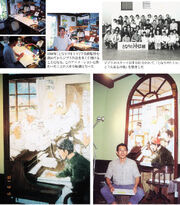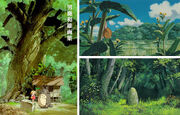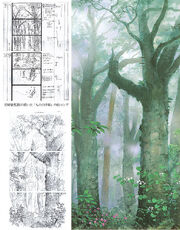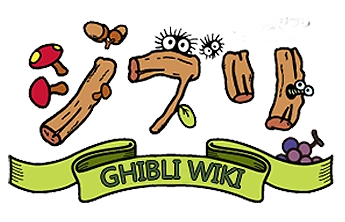Kazuo Oga (男鹿 和雄, Oga Kazuo, born February 29, 1952, in Akita Prefecture, Japan) is an animator, art director and illustrator. He worked on numerous Studio Ghibli films, including My Neighbor Totoro, Only Yesterday, Whisper of the Heart, Porco Rosso and The Tale of the Princess Kaguya, and has worked closely with Hayao Miyazaki and Isao Takahata.
In 2006, he directed The Night of Taneyamagahara, a film based on a 1924 short story by Kenji Miyazawa. Tokuma Shoten published Kazuo Oga Illustration Collection (Ghibli THE ART Series) in June 1996, which highlighted his work for Studio Ghibli.
In 2007, the Ghibli Museum in Mitaka hosted Ghibli No Eshokunin – The One Who Painted Totoro’s Forest, a special commemorative exhibit.[1]
History[]
Early Career[]

Oga while working at Studio Ghibli.
Born on February 29, 1952, in Sambon Ohgi, Ota-cho, Semboku, Akita Prefecture (currently known as Daisen City). After graduating from Akita Prefectural Kakunodate High School, he dropped out of a design vocational school in a year.
On his way to school, he saw an animated advertising that inspired him to start drawing background art. In 1972, Oga joined Kobayashi Production at the Animation Art Company in 1972, along with his peer Shichiro Kobayashi. In 1975, he switch jobs for Kanban Design where he painted signboards. In 1977, he returned to Kobayashi Production to work on background art for the animated film Homeless Child. Following that, he transferred to MADHOUSE Animation Company and participated in animations such as Harmagedon: Genma Taisen and The Dagger of Kamui under veteran art director Takamura Mukuo. He was promoted to art director and worked on Barefoot Gen, Space-Time Traveler, and Wicked City. For Wicked City, a film based on Hideyuki Kikuchi's novel, Oga was pushed by director Yoshiaki Kawajiri to use bold colors for the film's backgrounds.
Studio Ghibli[]

Oga based many of Totoro's backgrounds on life in Akita. The poster here is for the 2007 exhibition The One Who Painted Totoro's Forest.
In 1987, he was scouted by Hayao Miyazaki through a friend, who had been looking for a new art director for his new film My Neighbor Totoro. The two first met at a station in Asagaya, and Oga was convinced after seeing Miyazaki's storyboards for the film. He was placed in charge of the "D" part (final act), which depicted scenes of midsummer in the lush Sayama Hills scenery. Miyazaki praised Oga's style, stating he had a "natural talent for using green (color)".
"It wasn't just a vague story like the art of the past, where you just had to have a field there. The director said, 'I want you to pay close attention to rural landscapes, trees, flowers, and so on.' I was very happy to hear the image of camphor tree and the story of the forest, which became the habitat of Totoro and the symbol of the story. I had never thought about it concretely, but I really wanted to do this kind of work. I'm glad I met him at that time," Oga added.

Oga's background work for Takahata's Only Yesterday.
He then worked with Isao Takahata on Grave of the Fireflies, Only Yesterday and Pom Poko, and has also received high praise from the acclaimed director.
For Only Yesterday, the film was set in Yamagata, Japan, a prefecture known for its production of safflower. Director Takahata considered hiring Kazuo Oga as he grew up in the Tōhoku region. Not only was Oga tasked with painting the safflower fields, he also painted the shopping street in front of the station in Toyota, which was based on a real-life location he was familiar with. He then worked on many forest scenes from Princess Mononoke and the opening backgrounds of Spirited Away and Howl's Moving Castle.[2] In an interview with Miyazaki said, "I think art in animated films has a decisive role in determining the dignity of a film. What kind of ambition did it have when I saw a film? It is overwhelmingly the power of art to convey that it is a movie." "Light, shadows and textures are thick enough to express human spirituality," he said.

The backgrounds of Mononoke, from Oga's draft to final painting.
For Mononoke, two years before its release, in 1995, Oga went on a research trip to Shirakami-Sanchi to depict the village of Emishi, where the main character, Ashitaka lived. He walked around Ajigasawa in Aomori Prefecture and Futatsumori in Fujisato Town, taking numerous pictures, and immersed himself in the land.
According to Oga, "Various expressions are created in the forest depending on the density of trees, the weather, the transition of light, etc. If you sprinkle what you see with your own eyes, the story will be convincing."
"There are many photo books of beech forests, but I don't know what the feet of the beech trees are and what the shape of the roots is. The grass and fallen leaves that cover the ground, and the differences between each beech tree. , The bark, the composition of the trees, the sunlight through the trees... At the same time as seeing the scenery three-dimensionally, I see them with my eyes and feel the air, and I pick up a lot of remarkable elements. It doesn't matter, there are quite a few surprises."

Oga released a book about his memories of his hometown in Akita Prefecture.
He added that the forest of the Forest Spirit in Mononoke is deep, steep and scary. When the battle is over and the wrath of the Forest Spirit subsides, the green comes back to the desolate land. The flowers that sprout in the forest are as vivid as walking in the scenery of early summer in Akita.
Oga currently works at his home atelier in Hachiōji, Tokyo, and continued to support both Ghibli directors throughout their careers. In the meantime, he also worked on illustrations, picture books, essays, and other non-animation work.
In 2003, Oga began work on the Co-op Ehime Ehime as a chief judge in the children's prints competition "Genius Children". In 2006, he directed Kenji Miyazawa the animated picture book-style feature The Night of Taneyamagahara.
Since then, Oga has held numerous exhibits for his works in various museums such as the Museum of Contemporary Art Tokyo.[3]
Works[]
Director[]
- The Night of Taneyamagahara (種山ヶ原の夜, Taneyamagahara no Yoru), 2006
Art Director[]
- The Fantastic Adventures of Unico - (ユニコ Unico), 1979
- Tomorrow's Joe 2 - (あしたのジョー2 Ashita no Jō Tsū), 1980
- Barefoot Gen - (はだしのゲン Hadashi no gen), 1983
- Toki no Tabibito -Time Stranger- - (時空の旅人 Toki no Tabibito), 1986
- Wicked City - (妖獣都市 Yōjū Toshi), 1987
- My Neighbor Totoro - (となりのトトロ Tonari no Totoro), 1988
- Girls in Summer Clothes - (夏服の少女たち Natsufuku no Shōjo-tachi), 1988
- Only Yesterday - (おもひでぽろぽろ Omohide Poro Poro), 1991
- Pom Poko - (平成狸合戦ぽんぽこ Heisei Tanuki Gassen Pon Poko), 1994
- Princess Mononoke - (もののけ姫 Mononoke Hime), 1997
- The Tale of Princess Kaguya - (かぐや姫の物語 Kaguya-hime no Monogatari), 2013
Art Director[]
- Treasure Island - (宝島 Takarajima), 1978
- Cobra: Space Adventure - (コブラ スペースアドベンチャー Kobura Supēsu Adobenchā), 1982
Background Art[]
- Panda! Go, Panda! and the Rainy-Day Circus - (パンダコパンダ 雨降りサーカスの巻 Panda Kopanda: Amefuri Sākasu no Maki), 1973
- Adventures of Ganba - (ガンバの冒険 Ganba no Bōken), 1975
- Nobody's Boy: Remi - (家なき子 Ie Naki Ko), 1977
- Makoto-chan - (まことちゃん Makoto Chan), 1980
- Harmagedon - (幻魔大戦 Genma Taisen), 1983
- Unico in the Island of Magic - (ユニコ 魔法の島へ Unico: Mahō no Shima e), 1983
- Lensman - (SF 新世紀 レンズマン SF Shinseiki Lensman), 1984
- The Dagger of Kamui - (カムイの剣 Kamui no Ken), 1985
- Barefoot Gen 2 - (はだしのゲン2 Hadashi no Gen 2), 1986
- Hoero! Bun Bun - (ほえろブンブン Hoero! Bun Bun), 1987
- Bride of Deimos - (悪魔の花嫁 蘭の組曲 Akuma no Hanayome - Ran no Kumikyoku), 1988
- Demon City Shinjuku - (魔界都市 新宿 Makai Toshi: Shinjuku), 1988
- Goku: Midnight Eye - (Midnight Eye ゴクウ Midnight Eye Gokū), 1989
- Kiki's Delivery Service - (魔女の宅急便 Majo no Takkyūbin), 1989
- Urusei Yatsura: Always My Darling - (うる星やつら いつだってマイ・ダーリン Urusei Yatsura Itsudatte Mai Dārin), 1991
- Porco Rosso - (紅の豚 Kurenai no Buta), 1992
- Ninja Scroll - (獣兵衛忍風帖 Jūbē Ninpūchō), 1993
- On Your Mark - (オン・ユア・マーク On Yua Māku), 1995
- Whisper of the Heart - (耳をすませば Mimi o Sumaseba), 1995
- Rurouni Kenshin: The Motion Picture - (るろうに剣心 -明治剣客浪漫譚- 維新志士への鎮魂歌 Rurōni Kenshin Meiji Kenkaku Rōmantan Ishin Shishi e no Requiem), 1997
- Vampire Hunter D: Bloodlust - (バンパイアハンターD Banpaia hantâ D), 2000
- Spirited Away - (千と千尋の神隠し Sen to Chihiro no Kamikakushi), 2001
- InuYasha the Movie: Affections Touching Across Time - (映画犬夜叉 時代を越える想い Eiga Inuyasha: Toki o Koeru Omoi), 2001
- The Cat Returns - (猫の恩返し Neko no Ongaeshi), 2002
- Fantastic Children - (ファンタジックチルドレン Fantajikku Chirudoren), 2004
- Howl's Moving Castle - (ハウルの動く城 Hauru no Ugoku Shiro), 2004
- The Girl Who Leapt Through Time - (時をかける少女 Toki o Kakeru Shōjo), 2006
- Tales from Earthsea - (ゲド戦記 Gedo Senki), 2006
- Highlander: The Search for Vengeance 2007
- Ponyo - (崖の上のポニョ Gake no Ue no Ponyo), 2008
- Kawa no Hikari - (川の光 Kawa no Hikari), 2009
- Summer Wars - (サマーウォーズ Samā Wōzu), 2009
- The Secret World of Arrietty - (借りぐらしのアリエッティ Kari-gurashi no Arietti), 2010
- A Letter to Momo - (ももへの手紙 Momo e no Tegami), 2012
Art Books[]
- Kazuo Oga Art Collection (Oga Kazuo Gashuu). Tokuma Shoten, 1996. ISBN 4-19-860526-2
- Kazuo Oga Art Collection II (Oga Kazuo Gashuu II). Tokuma Shoten, 2005. ISBN 4-19-862074-1
References[]
External Links[]
Information[]
 Kazuo Oga at the Internet Movie Database
Kazuo Oga at the Internet Movie Database  Kazuo Oga on Anime News Network
Kazuo Oga on Anime News Network Kazuo Oga on Wikipedia
Kazuo Oga on Wikipedia- Kazuo Oga Profile
Online Shopping[]
- Kazuo Oga's Book on Amazon
[]
| |||||||||||||||||||
